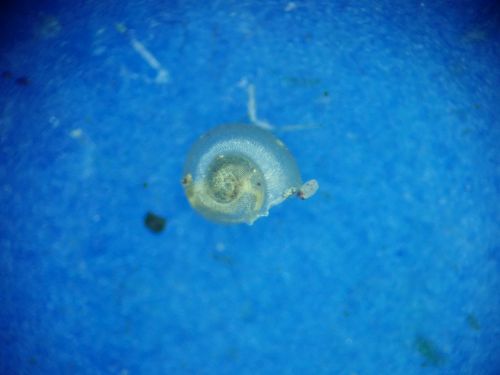Plants and Animals
Striatura meridionalis Median striate
Key Characteristics
The median striate is a minute (to about .08 inches) land snail with a shiny, pale yellowish-green and coarsely ribbed shell which is wider than it is high, with an average of 3 whorls and a round aperature. The snail body is large in comparison to the shell size, with long, slender eye peduncles, and small tentacles.
Status and Rank
US Status: No Status/Not Listed
State Status: SC - Special Concern (rare or uncertain; not legally protected)
Global Rank: G5 - Secure
State Rank: SNR - Not ranked
Occurrences
| County | Number of Occurrences | Year Last Observed |
|---|---|---|
| Kalamazoo | 5 | 2022 |
| Mackinac | 1 | 2013 |
| Oceana | 2 | 2023 |
Information is summarized from MNFI's database of rare species and community occurrences. Data may not reflect true distribution since much of the state has not been thoroughly surveyed.
Habitat
This species is found in the leaf litter of wooded hillsides, floodplains and ravines (Hubricht 1985).
Natural Community Types
For each species, lists of natural communities were derived from review of the nearly 6,500 element occurrences in the MNFI database, in addition to herbarium label data for some taxa. In most cases, at least one specimen record exists for each listed natural community. For certain taxa, especially poorly collected or extirpated species of prairie and savanna habitats, natural community lists were derived from inferences from collection sites and habitat preferences in immediately adjacent states (particularly Indiana and Illinois). Natural communities are not listed for those species documented only from altered or ruderal habitats in Michigan, especially for taxa that occur in a variety of habitats outside of the state.
Natural communities are not listed in order of frequency of occurrence, but are rather derived from the full set of natural communities, organized by Ecological Group. In many cases, the general habitat descriptions should provide greater clarity and direction to the surveyor. In future versions of the Rare Species Explorer, we hope to incorporate natural community fidelity ranks for each taxon.
Management Recommendations
As the median striate depends on moist organic litter of the forest floor, habitat management measures such as preserving unfragmented forest areas where canopy and ground cover remain in tact will benefit this species. Herbicide/insecticide spraying of locations occupied by vulnerable snail species should be avoided, as chemicals and heavy metals are bioaccumulated by snails (Berger and Dallinger 1993, Regoli et al. 2006). High exposure to heavy metals in the environment have been found to alter snail feeding habits and prevent reproduction (Notten et al. 2006).
Active Period
Breeding from first week of May to fourth week of June
Survey Methods
As visual detection of this species is difficult, specimens are collected by litter sampling in suitable habitat. Samples are thoroughly heat-dried, soaked in water for a number of hours to separate the various components, and finally passed through a series of sieves. The shells are then able to be hand-picked from the remaining sample material (Nekola 2003).
Litter sampling
Survey Period: From first week of April to first week of October
Time of Day: Daytime
References
Survey References
- Nekola, J.C. 2003. Large-scale terrestrial gastropod community composition patterns in the Great Lakes region of North America. Diversity and Distributions 9:55-71.
Technical References
- Baker, F.C. 1939. Fieldbook of Illinois Land Snails. Illinois Natural History Survey Manual 2, Urbana, Illinois. 166pp.
- Berger, B. and R. Dallinger. 1993. Terrestrial snails as quantitative indicators of environmental metal pollution. Environmental Monitoring and Assessment 25(1):65-84.
- Burch, J.B. 1962. How to Know the Eastern Land Snails. William C. Brown Company Publishers, Dubuque. 214 pp.
- Hubricht, L. 1985. The Distributions of Native Land Mollusks of the Eastern US. Field Museum of Natural History. Fieldiana: Zoology, No. 24.
- Notten, M.J.M., A.J.P. Oosthoek, J. Rozema, and R. Aerts. 2006. Heavy metal pollution affects consumption and reproduction of the landsnail Cepaea nemoralis fed on naturally polluted Urtica dioica leaves. Ecotoxicology 15(3):295-304.
- Regoli, F., S. Gorbi, D. Fattorini, S. Tedesco, A. Notti, N. Machella, R. Bocchetti, M. Benedetti, and F. Piva. 2006. Use of the Land Snail Helix aspersa as Sentinel Organism for Monitoring Ecotoxicologic Effects of Urban Pollution: An Integrated Approach. Environmental Health Perspectives 114(1):63-69.


